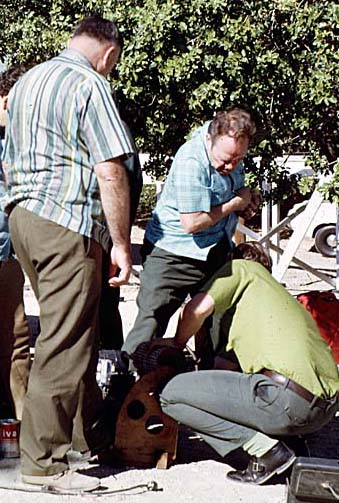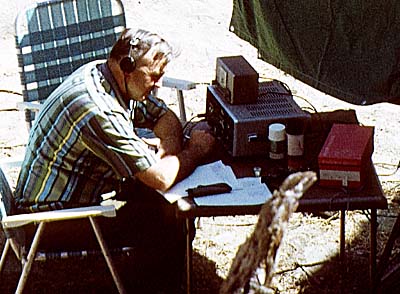
W6VIO CONQUERS (?) FIELD DAY
The 1971 ARRL Field Day exercise is now history. W6VIO's participation is also history and, as some participants may point out, something hopefully to learn from. As the story unfolded to this reporter, it seemed to be a comedy of errors, but probably not very funny to those involved at the time.
The site for W6VIO's operation was indeed an enviable one, atop the highest point on Mt. Wilson, only 150 yards east of the giant 100-inch Hale telescope. For extra insurance, the 2-meter beam was mounted at the top of the Solar Telescope tower, giving VHF'ers full line-of-sight view from San Diego to Santa Barbara. (We had to take their word for this, because at the time we arrived to observe operations, the smog was blotting out Altadena below the peak!)
Four operating posts were set up at the site and one rig went on the air at the exact time specified for the start of the exercise; the other three rigs followed suit shortly after.
Things started off in fine fashion on Saturday morning when the JPL generator turned up with shorted field diodes ("field" diodes -- "field" day?? Could there be a connection?) And, as the saying goes, the generator wouldn't gen. A quick scramble took place and Nash Williams' little putt-putt was lashed up to the line. However, it was rated at only 500 watts, while all the rigs in full cry were demanding close to 700! Ohm's Law being what it is, the line supply voltage immediately settled down to a soggy 75, giving birth to a multitude of chirping birdies atop Mt. Wilson.
Things went chirruping along until 4 AM the next morning. Apparently a good supply of gasoline was brought along, but did anyone think about bringing up some extra oil? You guessed it: Nash's generator ran out of oil and seized tight!
 By
8 AM Stan Brokyl staged an assault run up the hill and unstuck
the mighty midget with liberal doses of penetrant and expletives,
putting W6VIO back on the air. Meanwhile, another rig, working
off a 12-volt battery-generator setup, also ran into a snag.
After setting up and operating for about 4 hours, someone happened
to check the power unit and discovered that the switch between
the generator and the battery had never been closed! The battery
plates were not the only things bent slightly out of shape by
that time
By
8 AM Stan Brokyl staged an assault run up the hill and unstuck
the mighty midget with liberal doses of penetrant and expletives,
putting W6VIO back on the air. Meanwhile, another rig, working
off a 12-volt battery-generator setup, also ran into a snag.
After setting up and operating for about 4 hours, someone happened
to check the power unit and discovered that the switch between
the generator and the battery had never been closed! The battery
plates were not the only things bent slightly out of shape by
that time
The cutoff time for operations was 11 AM Sunday morning; by that time W6VIO had made a total of 709 contacts, good for about 1800 points. In comparing this performance with other club stations in the same classification, and scores made in past Field Days, W6VIO should rank up somewhere in the middle -- really not bad for the first time out.

Jay Bastow, WB6NFN, Operating
Station 1

Station 2

Station 3

Merv MacMedan, W6IUV, Operating
Station 4
Mt. Wilson, as a radio noise location, turned out to be practically dead quiet, considering all of the RF floating about that area from the TV stations. The personnel at the observatory were very helpful in many ways and our thanks goes to them for their cooperation. Thanks should also go to those stalwarts who braved the smogless atmosphere for 24 straight hours to man the rigs, and for the tremendous cleanup job done afterwards. This reporter couldn't believe anyone had been there, when the site was pointed out afterwards. Apparently this has led to an invitation to return for the 1972 Field Day exercise and you can rest assured that all contingencies will be covered next year to stay on the air for 24 straight hours -- or will they??
OSCAR TEST FLIGHT PLANNED
Perry Klein/K3JTE, President of AMSAT Corp., and Walt Ross/W6VPN, our Club President announced the formation of an ad hoc committee for the AMSAT-OSCAR Transponder Test Flight; the committee is chaired by Norm Chalfin/K6PGX. This JPL group will fly an engineering prototype of the OSCAR (AO-B) transponder that is scheduled to be launched piggyback on a NASA vehicle next February.
The test flight will be similar to the one performed on the east coast last May (see CQ Magazine, June '71). The west coast flight is tentatively planned for September, and will be from San Diego to San Francisco, to Sacramento and back down the San Joaquin Valley to Los Angeles.
Special FCC authority has been granted for Technician Class licensees' transmissions to be repeated on the 10-meter band. The call sign will be WA3NDS/ Aeronautical Mobile.
The pilot for this flight will be Booth Hartley/K6KVC; co-pilot will be Maurice Piroumian/WB60PB and; Dick Ulrich/K6KCY will be the flight engineer. Backup copilot will be Gene Thom, and backup flight engineer will be Gil Schuler.
For the technically-minded, the repeater being built by AMSAT is one of three being constructed; one is being built by a group of radio amateurs in Australia and another is being built in Europe by members of Region I of the IARU.
The US-built repeater has a 2-watt p.e.p. linear transmitter and has the capability of receiving signals in a segment of the 2-meter band approximately 100 kHz wide centered on 145.96 MHz. These signals will be relayed in a similar segment in the 10-meter band, centered at about 29.5 MHz. This repeater will be capable of relaying any type of modulation permitted in these two bands.
The AO-B satellite will be solar-powered and it is being designed to have a useful life of at least a year. The satellite will also transmit signals that will be used for telemetry measurements and tracking. Special circuitry aboard will allow its transmitters to be controlled from the ground in the event it becomes necessary to shut them off, either to conserve power or to eliminate interference.
During the flight test, the aircraft will cruise between 10,000 and 12,000 feet altitude. At this height, the radio horizon should be about 150 miles, allowing communication through the repeater between stations as much as 300 miles apart. Since there is the possibility that the 10-meter downlink signal may also be propagated by the ionosphere, signals from the repeater may be received over much greater distances.
NEW CLUB MEMBERS SIGNED UP
Club Treasurer Jay Bastow is sporting an ear-to-ear grin nowadays. When asked why, he doesn't say much, but just shows you a list of the new Club members that have signed up since June 1st. Here it is: